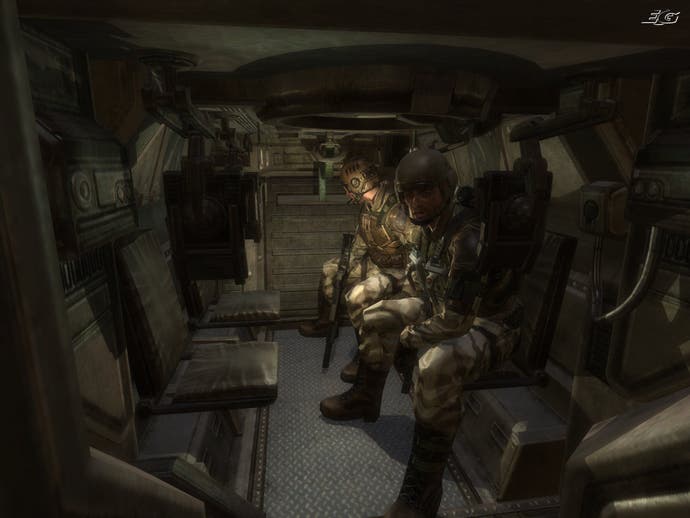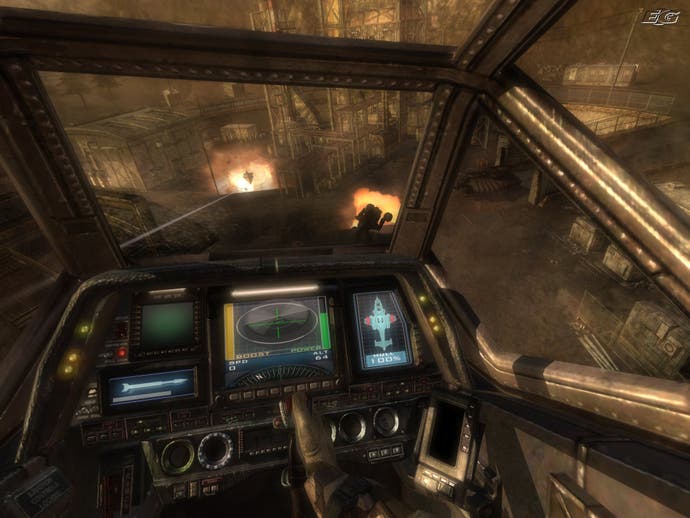Enemy Territory: Quake Wars
The Battlefield of the future?

In terms of the differences between GDF and Strogg player classes, the Strogg are "more animalistic" according to Wedgwood - for example, where medics heal fallen soldiers, Stroggs turn them into virtual spawnpoints - but one overarching difference is the Strogg's actual vitality and munitions. The Strogg survive on something called stroyent, which is harvested from organisms in their way (in this case humans) and used as health and ammo, and you can manually adjust the balance of available stroyent to compensate if you, say, have tons of health and no ammo. You also don't need to reload, but do need to worry about guns running hot. The guns themselves, of course, bare little relation to the rocket launchers, assault rifles and whatnot of the GDF.
Aesthetically of course the differences are huge - the humans are very conventional, while Strogg are mean, blood-splattered bastards with guns borged to their arms and such. They also see the world slightly differently - zooming in and out produces display artefacts that reflect the way Stroggs receive visual data, and when being shot you see screen interference. Telling units apart is simple too. The Strogg class similar to an engineer has his brain hanging out of the back of his head, and animation routines on both side help do away with the need to have a complex HUD with on-screen pointers and so on; you'll know a guy is agreeing to cover you because he'll yank out his assault rifle, you'll know someone has their knife out because of the type of crouching stance and, well, the knife clearly in his hand.
Visually the game hasn't lost anything in its escape from its technical origins. Enemy Territory began life as the Doom 3 engine. "As most people know, it's predominantly a linear, first-person, single-player, indoor shooter," Wedgwood says of the Doom engine, "and this is an outdoor multiplayer game with vehicles [laughs]." It's doing well - foliage is lush, human/Strogg and vehicle models are well animated, and it makes good use of its tech to simplify what it has to tell you in words. Seeking cover, for example, you judge how well hidden you are by whether any light falls on the arms and hands holding your gun in front of you.

The key technical change, of which much has been made in the game's early press, is the addition of the "megatexture", something John Carmack - who else? - came up with. It's basically the idea of covering the entire 32,000 pixels-square in one texture. Entirely unique landscape from start to end. Instead of painting textures onto polygons, designers specify what certain areas should be by proxy, so environmentally you can order the map to display weathered grey rock or churned mud near a river, moss below a certain height, and so on. "They start off about eight gigabytes," Wedgwood says, somewhat wince-inducingly, "but we scale that down until it takes up about 8MB of your video memory." Oh. When you zoom out, there's very little loss in texture quality; when you peer down a road, it looks different all the way along.
Network code has also been redesigned, with vehicle physics a key consideration. "Ordinarily in a multiplayer game the best that you can hope for is a straightforward rigid body model that moves across a very smooth landscape, which means you can't do jumps, you can't go offroading and all that. Because we actually have four-wheel-drive vehicles and proper suspension in multiplayer, we can model things like a limited split differential, the way the brakes work. ... Whatever I expect the vehicle to do, it's going to do." Wedgwood proceeds to donut a Humvee-style 'badger' vehicle around a GDF outpost.

Throughout all this, the key word is "teamplay". Wedgwood says it a lot. Of course there is some scope for personal achievement - an experience points system, which is being worked on at the moment, carries through each campaign, and Wedgwood promises it won't be as simplistic as something like CTF assists. "You can't just stand next to a flag and bank some points." They're also toying with the idea of persistent ranks. But it is a team game first and foremost. With absolutely no single-player in the box. As to what is in the box, there's talk of 12 maps, although they may cut or add maps right up to the last minute, and Wedgwood's quite clear about why: "It doesn't matter if we've spent six months on one, if we're not happy with it and it's not fun we're not going to ship it," he states.
However many there are eventually, by concentrating players into small fire teams, focusing the combat in one area and establishing close ties between each class, Enemy Territory promises the kind of accessibility that people who always got lost in the desert in BF2 will find appealing. At the same time, it's a team focus that people who didn't get lost in the desert will flock to with just as much interest. The real issue right now is simply balancing, which is quite a big deal in this kind of asymmetrical setup. "We really do mean they aren't just reskinned versions of the GDF forces," Wedgwood says when comparing Strogg to GDF. "You can do equations like damage over time to balance out character classes, but we're not doing that." How is it done then? "I think Activision allocated about 11,500 hours of QA to Wolfenstein Enemy Territory," he says, grinning, "and we expect this to be much more." Crivens.
We'll see how they got on later in the year.
Enemy Territory: Quake Wars is due out later in 2006.


.png?width=291&height=164&fit=crop&quality=80&format=jpg&auto=webp)




.jpg?width=291&height=164&fit=crop&quality=80&format=jpg&auto=webp)
